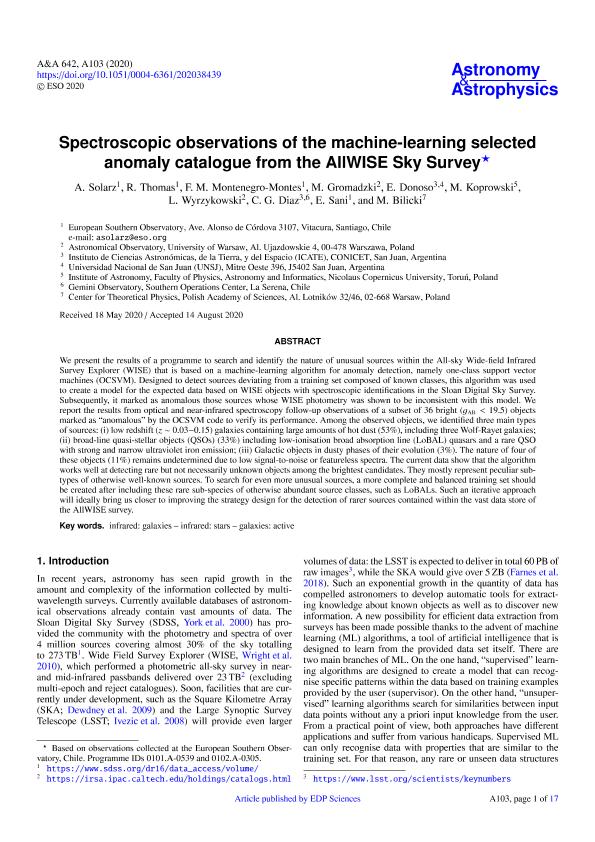Artículo
Spectroscopic observations of the machine-learning selected anomaly catalogue from the AllWISE Sky Survey
Solarz, Aleksandra; Thomas, Romain; Montenegro Montes, Francisco; Gromadzki, Mariusz; Donoso, Emilio ; Koprowski, Maciej; Wyrzykowski, Lukasz; Diaz, Carlos Gonzalo
; Koprowski, Maciej; Wyrzykowski, Lukasz; Diaz, Carlos Gonzalo ; Sani, Eleonora; Bilicki, Maciej Andrzej
; Sani, Eleonora; Bilicki, Maciej Andrzej
 ; Koprowski, Maciej; Wyrzykowski, Lukasz; Diaz, Carlos Gonzalo
; Koprowski, Maciej; Wyrzykowski, Lukasz; Diaz, Carlos Gonzalo ; Sani, Eleonora; Bilicki, Maciej Andrzej
; Sani, Eleonora; Bilicki, Maciej Andrzej
Fecha de publicación:
12/10/2020
Editorial:
EDP Sciences
Revista:
Astronomy and Astrophysics
ISSN:
0004-6361
Idioma:
Inglés
Tipo de recurso:
Artículo publicado
Clasificación temática:
Resumen
We present the results of a programme to search and identify the nature of unusual sources within the All-sky Wide-field Infrared Survey Explorer (WISE) that is based on a machine-learning algorithm for anomaly detection, namely one-class support vector machines (OCSVM). Designed to detect sources deviating from a training set composed of known classes, this algorithm was used to create a model for the expected data based on WISE objects with spectroscopic identifications in the Sloan Digital Sky Survey. Subsequently, it marked as anomalous those sources whose WISE photometry was shown to be inconsistent with this model. We report the results from optical and near-infrared spectroscopy follow-up observations of a subset of 36 bright (gAB < 19.5) objects marked as "anomalous"by the OCSVM code to verify its performance. Among the observed objects, we identified three main types of sources: (i) low redshift (z ∼ 0.03 - 0.15) galaxies containing large amounts of hot dust (53%), including three Wolf-Rayet galaxies; (ii) broad-line quasi-stellar objects (QSOs) (33%) including low-ionisation broad absorption line (LoBAL) quasars and a rare QSO with strong and narrow ultraviolet iron emission; (iii) Galactic objects in dusty phases of their evolution (3%). The nature of four of these objects (11%) remains undetermined due to low signal-to-noise or featureless spectra. The current data show that the algorithm works well at detecting rare but not necessarily unknown objects among the brightest candidates. They mostly represent peculiar sub-types of otherwise well-known sources. To search for even more unusual sources, a more complete and balanced training set should be created after including these rare sub-species of otherwise abundant source classes, such as LoBALs. Such an iterative approach will ideally bring us closer to improving the strategy design for the detection of rarer sources contained within the vast data store of the AllWISE survey.
Palabras clave:
GALAXIES: ACTIVE
,
INFRARED: GALAXIES
,
INFRARED: STARS
Archivos asociados
Licencia
Identificadores
Colecciones
Articulos(ICATE)
Articulos de INST.D/CS ASTRONOMICAS D/LA TIERRA Y DEL ESPACIO
Articulos de INST.D/CS ASTRONOMICAS D/LA TIERRA Y DEL ESPACIO
Citación
Solarz, Aleksandra; Thomas, Romain; Montenegro Montes, Francisco; Gromadzki, Mariusz; Donoso, Emilio; et al.; Spectroscopic observations of the machine-learning selected anomaly catalogue from the AllWISE Sky Survey; EDP Sciences; Astronomy and Astrophysics; 642; A103; 12-10-2020; 1-17
Compartir
Altmétricas



